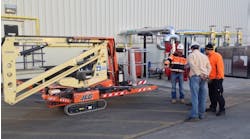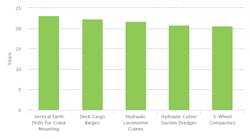The construction economy is heating up. Rental company executives and their customers, for the most part, believe the cycle is just starting to gain some momentum, and there’s a good ways to go in an uphill climb.
According to most economists in North America, we’re in the early innings of a fairly strong construction and industrial cycle that should mean strong business for equipment rental companies for the next few years. And, from recent interviews by RER, most rental companies agree, having posted strong results in 2014 and expecting to do the same in 2015. That certainly doesn’t mean there are no exceptions, nor obstacles and concerns, because there are. But the basic economic indicators and performances of rental companies continue to show an upward trend. And mindful of what happened in the last recession, they are tending to press down slowly on the accelerator.
“Most people will tell you that we’re not in the seventh or eighth inning of a construction cycle, we’re in the second or third,” says Shawn Severson of the Blueshirt Group, San Francisco. “So the amount of cash and EBITDA that rental companies will generate in this cycle compared to the last cycle would actually be much greater because even though we’re only in the early stages of expansion, they’re already achieving excellent EBITDA margins. If they can sustain strong EBITDA margins for three to five years versus in other cycles when they did it for one or two years, the industry as a whole should have a very good cycle.”
Most of the rental companies contacted by RER report strong growth in 2014, in many cases double digits. Some companies expect 2015 to be even better, some not quite as strong, but outpacing the economy as a whole is the overall expectation for rental companies. And rental companies are tending to be cautious and balanced as they grow, paying attention to the structure of their balance sheets and carefully walking a fine line between fast growth and the tendency to become over-leveraged as they recall the lessons of the last recession.
“Neff Rental had another very successful year in 2014, driven primarily by the continued strength of our end markets, the ongoing recovery in the economy, the growth of rental penetration rates and the strong performance and execution by our employees,” says Graham Hood, CEO of Neff Rental.
“We had tremendous top line and bottom growth and most importantly were able to add some really quality people and depth to our team,” says James Horsley, Champion Rentals, Houston. “We purchased a 9.5 acre tract of land on which we plan to build a new corporate office and rental facility.”
Most regions are expecting growth. For example, California, which was one of the first markets to capsize during the recession and was slow to revive, seems to be on a strong growth path according to several respondents in the Golden State.
“In our region commercial growth has dominated,” says Rob Pedersen, CEO of Campbell, Calif.-based A Tool Shed, which has several branches in and around the San Francisco and San Jose areas. “Tech companies continue to build new and add onto existing campuses. The addition of the Levi’s Stadium and the San Jose Earthquakes new stadium projects were a boom and the infrastructure growth that surrounds them will continue for the next two years. Health care facilities continue to expand in California as the demand for their services increases.”
John Grill of A Action Rents based in Windsor, Calif., north of San Francisco adds: “We anticipate growth in the residential housing market, a continued strong wine industry, and some of the underground contractors who all but closed their doors during the recession are gearing back up.”
“BJ’s Rentals had a great year in 2014 and we expect it to continue into 2015,” adds Brad Thomas of San Diego-based BJ’s Rentals.
“2014 was consistent with our growth pattern of 8 to 12 percent and we are expecting similar results for 2015,” adds Brian LaLonde of LaLonde Equipment, Signal Hill, Calif.
Dale Blackwell of Aba Daba Rents, Sacramento, Calif., notes that his company is starting to see more of the contractors that it used to see before the recession hit. “The plumbers, the landscapers, the small- to mid-sized contractors, are making inquiries about different projects that they are bidding and looking at. So we’re optimistic.”
While the northeastern U.S. has not been the country’s strongest region, things are progressing well according to Deer Park, N.Y.-based Abel Equipment Rental.
“2014 was Able’s best year and we have benefited from many converging factors despite regional fluctuations and slightly lower-than-average growth in the U.S. Northeast where we operate,” says Able’s Joe McCaffrey. “Many mega projects, soaring mixed-use tower construction in New York City, significant infrastructure replacement and real estate repurposing are all places that Able sells, rents and services. We see these trends continuing in 2015 and as real estate plays pick up in areas rippling out from the dense Northeast cities, we anticipate that rental needs will rise in suburban and even rural areas.”
Bill Thompson, president of Thompson Pumps, which manufactures equipment as well as sells and rents, says 2014 was especially strong. “From a manufacturing/sales standpoint as well as from the rental perspective, 2014 was a surprisingly strong year,” he says. “Total revenue was up by almost 21 percent, which presented its own challenges as we adjusted to meet the higher activity levels. We expect the trend to continue into 2015 although probably not at the same degree. We’re planning for a 14 percent increase in revenue for this year.”
And Andy Studdert, chairman and CEO of NES Rentals, says: “We had record rental revenue, and rental revenue EBITDA grew close to 25 percent year over year. We feel very good about ’15 as well.”
While the energy markets seemed to be the leading drivers the past couple of years, and should still be viable in 2015, traditional construction and industrial areas are more likely to return to rental prominence with the recent drop in oil prices.
“Our growth has been strongly correlated to housing starts,” says Fred Daniels of Ames Taping Tools. “2014 saw strong multi-family growth, while single family was fairly flat. Commercial did very well for us in 2014. I expect those segments to continue to be strong in 2015 and for single family to start a bigger comeback.”
“Construction is rebounding, especially in the Southeast and it seems to be on a steady upward trend,” says Thompson. “A lot of that increase has been fueled by private investment in housing developments of all types. To support that sector, we’re seeing increased activity in rebuilding, repairing and adding new infrastructure – roads and highways, bridges, treatment plants, generating plants, etc. Mining has dropped off to a significant degree and oil and gas are on tenuous footing. Coal has been under siege for the last six-plus years. We anticipate that 2015 will see a continuation of high activity in construction and, if the Keystone XL pipeline is able to overcome political opposition, the refinery business in the Gulf area should show improvement. From the sales standpoint, our export business, which was extremely strong, is showing signs of weakening, probably due to the strengthening of the U.S. dollar.”
“All of the major end market segments that we serve showed strength and year-over-year revenue growth in 2014,” says Hood. “We expect those trends to continue in 2015 with a watchful eye on oil-related work, but we feel any retraction in that segment should be offset by the positive effect that lower oil prices will have on the general economy, helping drive consumer spending.”
Studdert adds that how lower oil prices will affect the industry is still to be determined but so far it’s a “net positive.”
“Nonresidential construction finally kicked in, our commercial sector was very strong, and of course we’re very well positioned in the Gulf Coast for petrochemical so that was a good year for us,” he says.
Darryl Cooper, whose Cooper Equipment Rental posted major growth in 2014, sees strong growth ahead. “Infrastructure was very strong in the GTA,” he says, referring to the greater Toronto area. “We expect the lower Canadian dollar to lift the manufacturing sector in our area as well. Residential continues to perform well.”
Bill Gex of Anderson Equipment Co., which posted solid results in 2014 after a tough early start because of the frigid winter—not unusual in 2014—and expects a 5- to 7-percent rental revenue spike in 2015, says “customers involved in the natural gas market continue to be strong. Energy-related customers should continue to be strong.” Anderson adds that his company had increased demand from its New England customers as that region continues a gradual recovery from the recession.
Base hits
Rental companies are moving forward, not necessarily with dramatic changes but with solid, consistent growth and steady re-tooling. For example, Seattle-based Star Rentals is implementing Point-of-Rental’s new POS system in connection with its new Sage MAS90 accounting software that it recently installed in 2014 and has plans for branch and headquarters expansions. CEO Bob Kendall says the company is diversifying its customer base to be less affected by the cycles of the construction industry.
Re-rental specialist Acme Lift spent a lot of time in 2014 shoring up its business model and re-focusing its fleet to concentrate on 135-, 150- and 180-foot boomlifts and larger telehandlers.
“Acme added eight positions in 2014 (plus me), which is big for us,” says Acme Lift president Michael Crouch. “All hires are incredibly strong. We have updated our software and hardware on all levels to top of the line and are ready for 2015. I may add a couple of business development-type positions this year.”
Able Equipment Rental opened a branch in the Philadelphia market, dramatically increased its fleet, became an authorized Kubota dealer, upgraded its rental software ERP, hired 25 new people, doubled its mobile repair group and increased the size of its territory.
Acme Taping Tools added a national accounts sales team and is expanding its business intelligence system and operating system.
“In 2014, we moved to further strengthen all areas of our company,” adds Thompson Pump’s Thompson. “We invested heavily in product research and development, added new personnel to handle the increase in activity, incorporated new computer hardware, conducted extensive employee and customer training and prepared our rental fleet, facilities and vehicle fleet for the increased demands which we predict 2015 will bring. All of the above demonstrates our confidence and optimism that we’re finally heading in the right direction in some market segments.”
For Neff Rentals, which took a more dramatic step in 2014 by becoming a public company, the company expects to grow organically by investing in its existing network of branches, conservatively growing its fleet to meet demand and drive improvements to the key metrics of rental rate and time utilization.
“We also expect to continue to expand our branch network at a measured pace into markets that complement our existing network,” adds CEO Hood.
During 2014, Toronto’s Cooper Equipment integrated its Dec. 2013 acquisition of City Rentals, completed another acquisition – Albion Rental in Bolton, Ontario – and plans to open its sixth branch soon.
Anderson Equipment spent significant resources on facility improvement, with a major renovation of its Olean, N.Y., facility, and is set to complete a new building in Gorham, near Portland, Maine. It also plans a major expansion of its Manchester, N.H., facility and will replace its Endicott, N.Y., branch with a new building in Binghamton, N.Y.
Aaction Rents launched a new website and started a “sparkle” program to extend the life of older equipment by painting units, replacing seats, tires, decals, re-bushing to improve equipment’s appearance as well as mechanical performance.
“In 2015, we will purchase a backup server, add a dispatch module, add alarm systems that utilize wireless cameras that are monitored at night, and add hydraulic hose machines at all stores,” says owner Grill.
Susan Stegman of F&M Mafco says the company has begun doing more special rental tool packaging to boost revenue, as well as rentals of non-traditional items and broadening the company’s customer base.
A Tool Shed’s Pedersen says ATS will take advantage of reaching the milestone of 70 years in business with a variety of business promotions and thank-you barbecues for its customers. And Mike O’Neal of Rental One, based in Fort Worth, Texas, says the company has expanded into a new region – central Texas – and would like to continue to add stores in that area.
Facing the curveballs
While most rental companies are doing well and economists predict an upward construction cycle for several years to come, no upturn is without obstacles and growth is never a sure thing, just like not all rental companies are doing equally well. One crane rental company CEO that spoke to RER says he expects a difficult road in 2015, with particularly tough times in the recently booming oil-and-gas industry. The continuing slump in oil prices is the first major concern on the minds of many.
But while growth in oil-and-gas exploration has slowed down, it’s still a vibrant sector. Particularly shale oil extraction and other oil exploration is not going to go away and the sector remains vibrant, although effects might be more serious if oil prices remain low for an extended period. And low oil prices will help the rental market in other ways as other industries will benefit, consumer confidence will rise and the costs of operating rental business will go down.
“We do expect some impact as rig counts come down, but we strongly disagree with the idea that our growth is at risk,” says Michael Kneeland, CEO of United Rentals. “We believe that any drag on demand for upstream oil will be mitigated by the positive effect on other industries. Take chemical manufacturing, one of our key sectors. When oil prices decline, manufacturing costs drop, production is stimulated and consumer purchasing power increases.”
One major concern in the industry, felt by companies of all sizes, is that the original cost of equipment is outpacing growth in rental rates. While some rental companies are seeing some increases in rental rates in their markets—and this is not felt in all markets by all companies—those increases cannot keep pace with often double-digit jumps in equipment costs fueled by the unavoidable expenses of keeping up with Tier 4 interim and final legislation.
“An ongoing challenge will be the ability to procure rental equipment at prices that will ultimately produce attractive returns,” says Anderson’s Gex. “As Tier 4 final product becomes more mainstream, acquisition costs will continue to rise. On the other hand, customers will resist price increases and their tendency to shop rates will likely increase.”
Gex adds that rental fleets have significantly grown within Anderson’s territory, as they have in most territories. As these fleets age, the supply of used equipment will increase he says, putting downward pressure on residual values. “Managing through the supply and demand of rental equipment sales will be an increasing challenge during the next two years,” he notes.
There are other challenges associated with Tier 4. “Tier 4 machines with filters and DEF fluid is going to be a major learning curve for both the rental customers and all maintenance departments,” says LaLonde.
“During 2015, we will continue to be fighting the battles associated with the implementation and integration of Final Tier 4 engines in our product design and in our rental fleet,” adds Thompson. “I can’t overestimate the turmoil, expense, disruption and consternation that these EPA mandates have caused in our industry. It has been enormous. That’s the bad news. The good news is that we have made excellent progress and a lot of our efforts will come to fruition in 2015.”
Thompson adds that a comparable challenge is finding qualified people, a concern echoed by many rental companies.
“Other than the economy, the biggest challenge we will continue to face in 2015 is employee training and development,” adds Champion’s Horsley. “The arrival of Tier 4, continued advancement of computerized control modules, regulatory and compliance requirements, teaching our staff safe equipment operating and product knowledge, and getting our new people to buy into our philosophy of service are ongoing personnel development concerns. We may not be able to control the economy, but we can control how we coach and train our team.”
“With growth comes the added staff, training and costs associated with it,” adds Pedersen. “As the government mandates more programs on employers it becomes harder to fairly compensate them for the work performed.”
Training is an issue for many rental companies. “The challenges we face include extensive trainings in new types of equipment for our sales team so they can accurately recommend solutions for our customers,” says Able Equipment’s McCaffrey adding that other challenges include “the adoption of additional software systems to help manage the business and increasing our footprint in offering products and services to manufacturing, warehousing and other industrial users.”
There are other concerns that are harder to control and predict, some coming from nature itself. “The big unknown for us is the drought,” says California’s Blackwell. “We’re affected a lot, especially customers such as landscapers and we deal with them a lot. There were quite a few projects that were postponed because of water shortages. If we don’t get more rain and snow to fill up the reservoirs, I’m afraid we’ll see rationing of water and that will affect people putting in a new yard or deciding they want to put in a pool or anything like that. So we’re keeping our fingers crossed that we’ll have a wet period but it’s not looking likely.”
Regulations are another concern for business owners, especially in California where California Air Resources Board permitting requirements add significant expenses and force rental companies to continually upgrade fleet, even in cases where old machines do the job effectively enough.
“We just sold one of our concrete trucks on an online auction because it was 10 years old and could not be retrofitted for air quality,” Blackwell adds. “So that truck is headed to Texas and we either replace it or deal with one less available in our fleet. We spent $17,000 to retrofit our last truck. It’s more difficult to stay above water with those kinds of expenditures.”
As all rental people know, such hurdles are constant challenges in the rental industry. If the construction economy continues as most economists and rental people expect, there should be enough business ahead to outweigh those issues. We could be in the early innings of an upturn, but rental companies need solid game plans and plenty of backup options for the innings to come.








